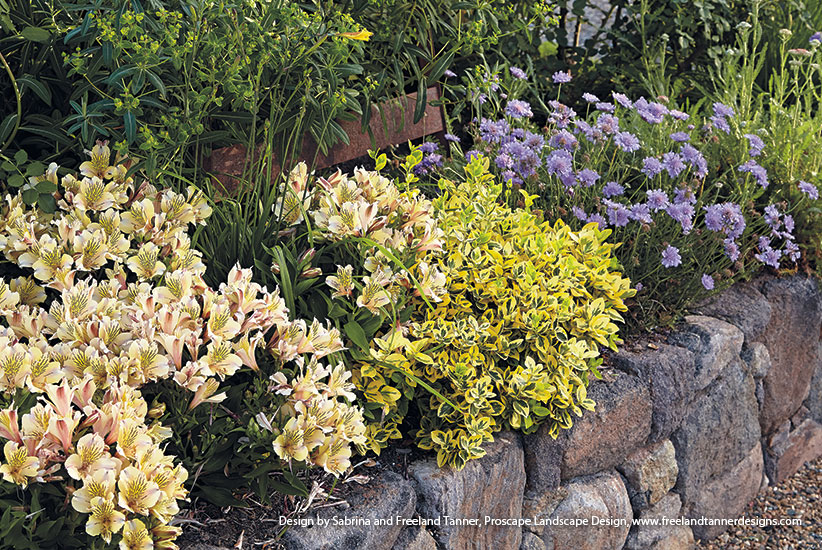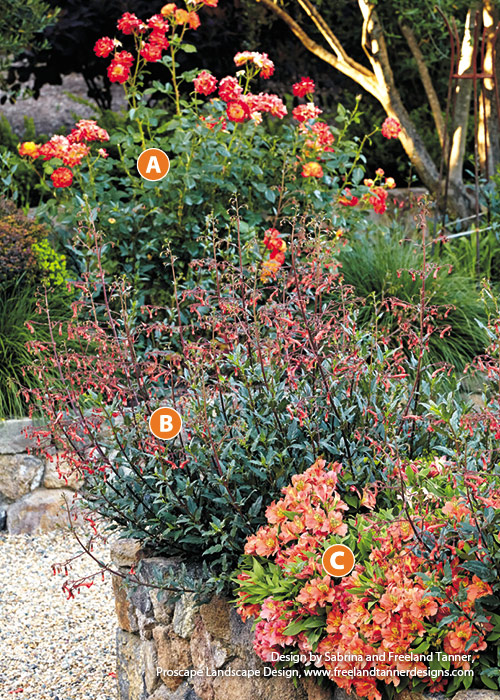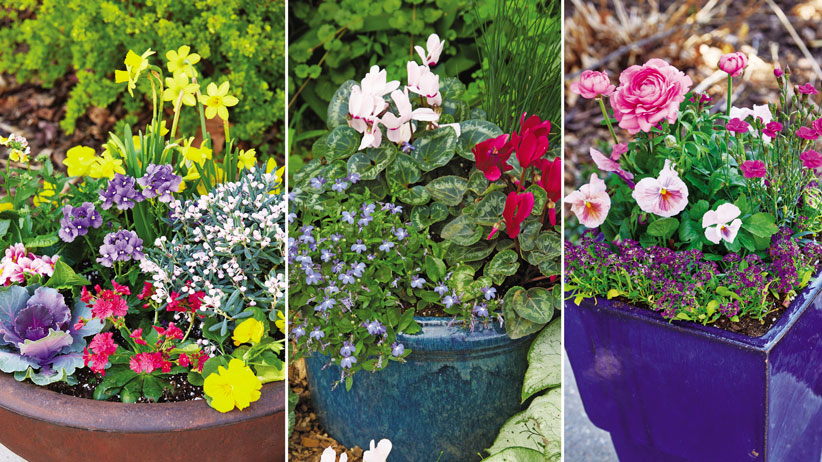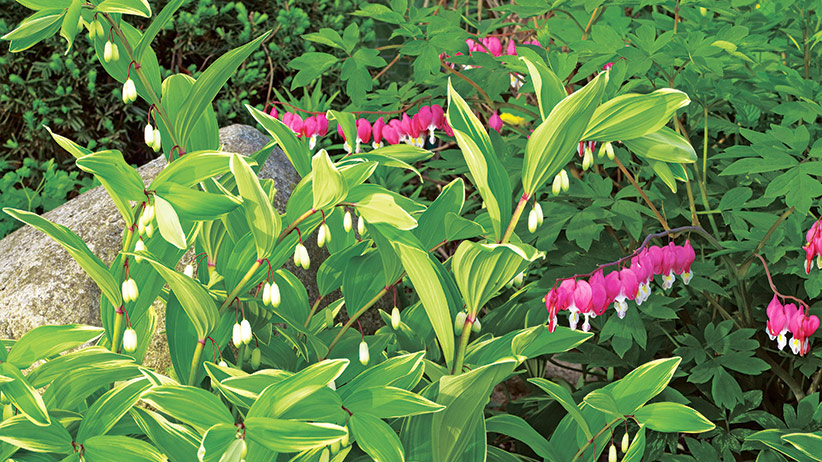
Gardening on a western slope in rocky soil with lots of sun and wind (plus deer and gophers!) is quite a challenge. But as you can see here, with stone raised garden beds and plants suited to the region you can get beautiful results. This zone 9 California garden started out as a rocky slope with soil too thin to support much in the way of plants. Excavating and replacing the soil can work for small beds, but this large space required a different approach.
Anatomy of a raised bed
Raised beds are a necessity for plants this lush and flower-filled in this area. They’re filled with a mix of topsoil and nutrient-rich compost that holds onto moisture and gives whatever’s growing there something to really sink its roots into. Besides making it possible to customize your soil mix to suit the plants you want to grow, raised beds make maintenance a lot easier — less getting down on the ground to pull weeds or deadhead flowers.
They’re made of stone dug up during the construction of the house. The bottoms of the beds are lined with gopher wire, a heavy duty fencing, to keep those furry pests from making themselves at home.

Stone raised garden bed layout
There are eight raised beds here, all 2 feet tall and 6 feet wide (which makes it easy to reach into for work) but in varying lengths from 12 to 25 feet long. They’re all connected by 6-foot-wide gravel paths. Small sharp-edged stones make up the path and knit together well so it’s easier to rake up the garden trimmings after a day of deadheading and weeding.
In the center path, a diamond-shaped raised bed filled with ground covers holds a dramatic New Zealand flax (Phormium hybrid) in an urn.
Keep plants in stone raised garden beds happy
Maintenance for this gorgeous garden is less than you might think, even in a hot, dry region. A layer of mulch added each year in early spring is critical for conserving water and keeping weeds down. The first layer of mulch is an inch or two of compost (made from garden debris, lawn trimmings and kitchen scraps) that slowly feeds the soil. This is topped off with another inch or so of shredded hardwood. A drip irrigation system on a timer keeps each plant in these stone raised garden beds watered efficiently and helps prevent fungal diseases that may develop from splashing water.

Color themes
Each raised bed has two shrub roses and a few other flowering plants for cutting. They bloom in colors that coordinate with the home’s interior so bouquets from the garden always look just right. The rich fall-like peachy oranges, pinks and reds with a pop of chartreuse are attention-getting. But without the blues and purples to contrast against them, they wouldn’t seem as intense and the beds wouldn’t have the same depth.
Let’s take a closer look at the plants that are in these raised beds.

Edge stone raised garden beds with color
You’ll love all the pollinators that show up for a snack on the pincushion flower and catmint. Bright foliage from the variegated Carmel creeper look good whenever flowers take a break from blooming for a bit.
Maintenance tips
- Deadhead the pincushion flower to encourage more blooms.
- To keep the catmint colorful, shear plants back by one third after the first flush, and you’ll get a repeat of blooms.
A) Catmint Nepeta racemosa ‘Blue Wonder’
Type Perennial Blooms Blue
flowers from spring to fall Light Full sun to part shade Size 9 to 18 in. tall, 12 to 18 in. wide Hardiness Cold hardy in USDA zones 3 to 8
B) Pincushion flower Scabiosa ‘Butterfly Blue’
Type Perennial Blooms Purple flowers from spring to fall Light Full sun Size 12 to 18 in. tall and wide Hardiness Cold hardy in USDA zones 4 to 9
C) Carmel creeper Ceanothus griseus horizontalis ‘Diamond
Heights’
Type Shrub Blooms Pale blue flowers in spring Light Full sun to part shade Size 10 to 12 in. tall, 48 to 60 in. wide Hardiness Cold hardy in USDA zones 8 to 10
You Might Also Like:
How to Make a Raised Garden Bed
Design With Repetition
Great Plant Combo Ideas

Cut flowers, anyone?
With all the flowers this group of plants produces, you’ll want to cut a few for bouquets to bring indoors. A mix of flower shapes gives you a beautiful instant bouquet. Peruvian lily’s long bloom time is legendary, and this dwarf cultivar makes it easy to fit into a garden of any size. The rose has a strong fragrance to enjoy, too.
Maintenance tips
- Pruning is simple for the two shrubs in this group: Remove any dead or damaged canes on the shrub rose in late winter and cut the cape fuchsia stems back to the ground in early spring.
- Remove the spent flowers of Peruvian lily at the base of the plant to encourage more.
A) Shrub rose Rosa Judy Garland
Type Shrub Blooms Yellow flowers edged with orange and red from spring to fall Light Full sun to part shade Size 3 to 4 ft. tall, 2 to 3 ft. wide Hardiness Cold hardy in USDA zones 5 to 9
B) Cape fuchsia Phygelius x rectus ‘Salmon Leap’
Type Shrub Blooms Salmon flowers from summer to fall Light Full sun to part shade Size 3 to 4 ft. tall and wide Hardiness Cold hardy in USDA zones 7 to 9
C) Peruvian lily Alstroemeria ‘Princess Mathilde’
Type Perennial Blooms Peach-orange flowers with burgundy flecks from late spring to fall Light Full sun to part shade Size 12 to 18 in. tall, 12 to 15 in. wide Hardiness Cold hardy in USDA zones 8 to 11
















